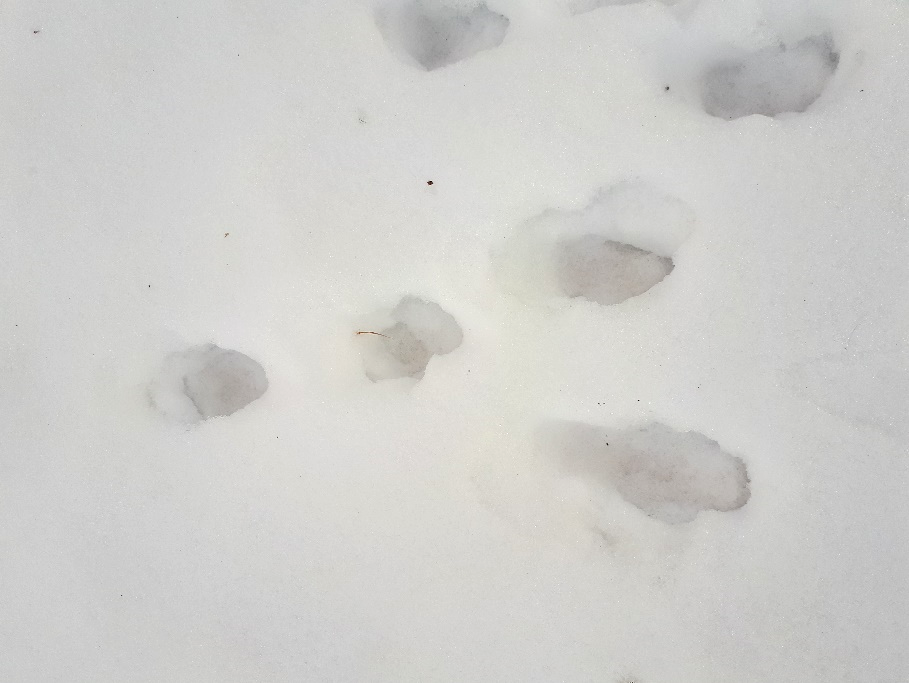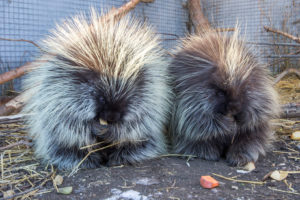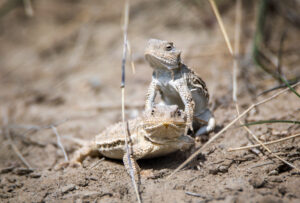By Maureen Perry
The snow is falling.
I’ve always wondered how we know it is snowing out at 3:00 am in a dark bedroom with the blinds closed. It’s like we can “sense” it rather than hear it. There is a soft, dreamy tinge to everything in the room.
Why am I awake? I ask myself. I’m thinking about a book my brother gave me when we visited this past weekend. It was perfect! A pocket sized book on animal tracks! I can easily slip this into my backpack or even a coat pocket while going out for a hike or snowshoeing.
As a wildlife lover, nothing seems more appealing than learning more about these animals in any way I can, starting with recognizing their tracks in the snow. I’ve heard there are people out there who can tell incredible amounts of information about an animal just from a footprint, like if they are stressed, hungry or just had a big meal. I want to know what these animal footprint experts know!
The morning after that restless night, I was heading to the car to brush the snow off when I happened to glance down. Tracks!! (Unbeknownst to me at that time, it was a hare who made these tracks)
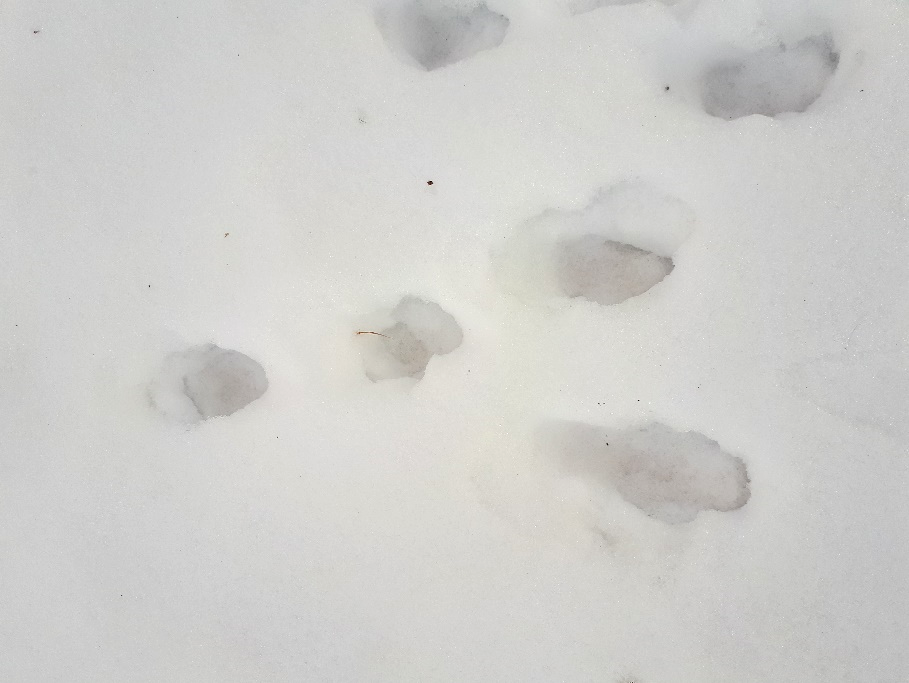
I dashed back in the house, grabbed my new animal tracks book, and dove into it looking for instructions on how I can tell what animal this is. What a rush! I felt like a private investigator.
My new book listed numerous animals, many of which have been reported to frequent the back yards of Calgarians such as skunks, bobcats, coyotes and hares.
Though exploring your backyard may not be your typical adventure, it brings to mind something I once heard: “we travel the world to see amazing things; in doing this, we miss the wonders in our own back yard”. Local wildlife has co-existed with us in Calgary since the beginning of this city. We don’t have to leave the city to learn about wildlife or see their footprints in the snow. We can just go in our backyard!
Tips and Tricks for Identifying Mammal Tracks
Only one in 100 tracks show toe or nail marks so when this happens we need to rely on our next step in our investigation. Luckily many animals have a particular way of walking which gives us the opportunity to decipher what animal left this footprint without looking at a single footprint. For example, squirrels and rabbits actually gallop but members of the canine family like foxes and coyotes walk in a straight line.
This particular way of walkingis referred to as a track pattern of which most animals can be grouped into one of the four patterns. Animals like the skunk and beaver have a pace pattern, animals from the dog and cat family have a diagonal pattern, weasels bound while animals such as hares and squirrels gallop (see diagram below).
.
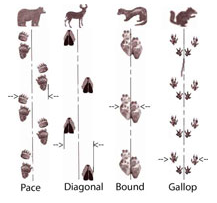
The next clue we can look at to help us narrow down even further the animal species, rather than just the animal family is the trail width measured in centimetres and it is the distance between each footprint. This will help us tell the difference between a chipmunk and red squirrel for example.
A tracking book with trail width data is a good investment to get you on your way!
Tracks in snow can be incredibly difficult to recognize but they can also occasionally be easy to name as well. As snow melts tracks can easily become distorted or expand dramatically, almost so much that a squirrel track can sometimes be mistaken for a bear track!
The grizzly bear photo below however is the real deal:
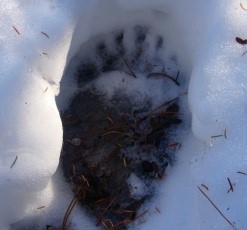
As we continue with learning animal foot prints it is now time for a pop quiz. What tracks are in this photo below? Looks kind of pigeon-toed, perhaps a pace pattern……
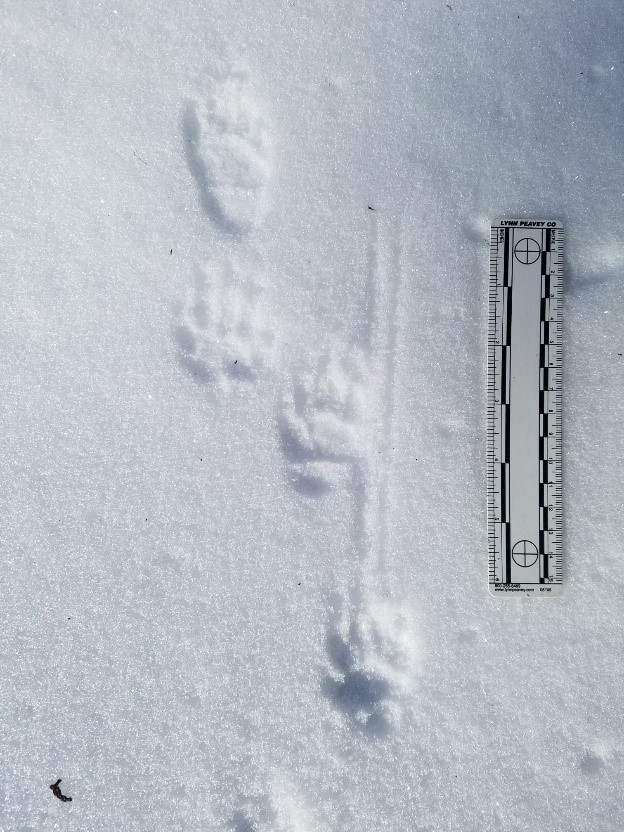
Yes, a skunk is the correct answer! Always good to have a visit from these guys in your yard. They are happy to dine on any mice or wasps that call your backyard home.
Skunks are well-defended by their spray, so they don’t often have a reason to run. Their footprints are quite irregular, and you can often see their long claws in a print. They sleep most of the winter unless it is a nice day that warrants an outing.
What About Bird Tracks?
Not all birds leave Calgary and area in the winter.
The list of birds that stay in Calgary all winter is now at 93 species!
I won’t list them, all but a few examples are the crow, black-capped chickadee, red breasted nuthatch, downy woodpecker and impressive native raptors such as the great-horned owl.
Time to put on your detective caps again!
Which local bird in my examples is responsible for these tracks below?
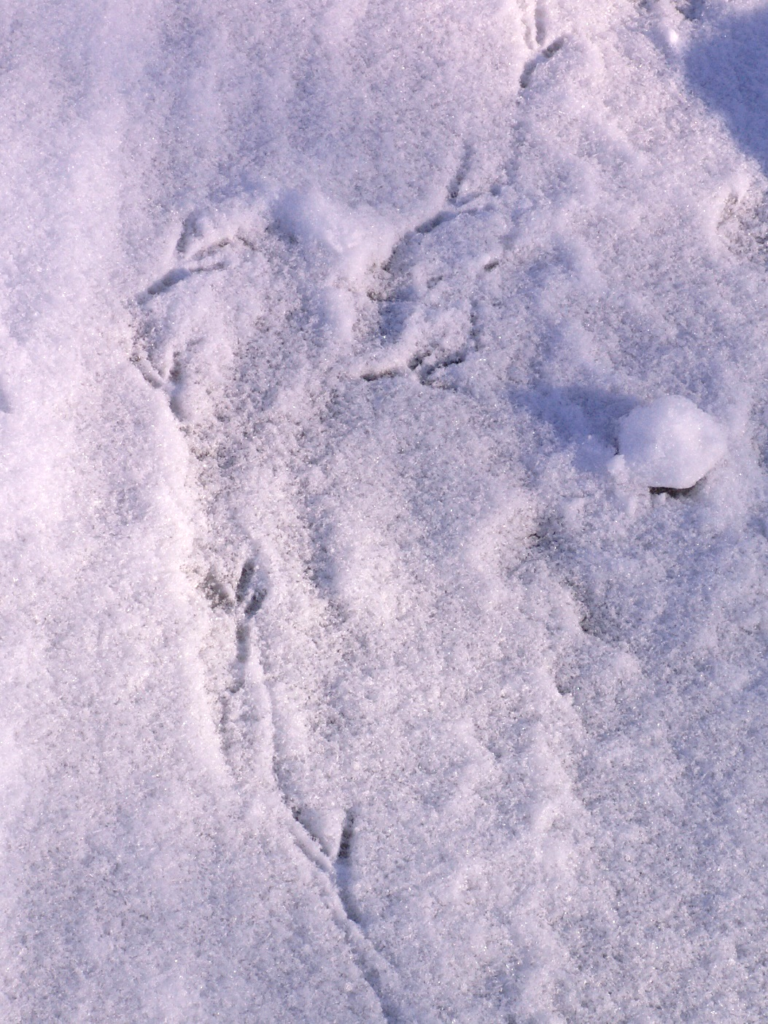
If you guess crow, then congratulations! You are a straight-A student of your backyard world!
The trail width of the crow footprint measures at 6.4-7.6 cm
Crows are pigeon toed and they walk and hop leaving thick toe prints in the snow. When they start talking off in flight the distance between footprints is longer.
Below is another print from one of my winter bird examples.
This is not a snow angel we made as children throwing ourselves into the snow, waving our arms and legs until an angel materializes. This is a local favourite raptor, the great-horned owl.
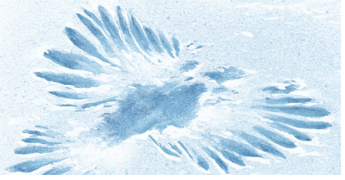
This print shows what it looks like when an owl lands on his prey in the snow. The centre of this mark is quite deep and pronounced since that is where the talons have ended the life of his prey. Their feather prints are deep in the snow due to the extra push from the owl’s wings as they struggled to take off in the deep now.
There is another world to discover for us in our backyard. In getting to know our neighbors, the local wildlife, we develop a better understanding, appreciation and respect as we have with the diverse people we share this country with.
My ongoing journey of learning about animal tracks has just begun. It feels similar to having gained entrance to a secret society where admittance requires a secret handshake or password, but I just require my Animal Tracks pocket book! See you outside!
Photo Sources
[i] Clifford, Chad. “Discovering the World of Animal Tracks”. Canadian Wildlife Federation. https://cwf-fcf.org/en/news/articles/animal-tracks.html. Accessed November 19, 2020.
[ii] Zachary Wardle. https://twitter.com/ZacharyMWardle
[iii] Wikimedia Commons. 2015. Crow tracks, Allegheny Cemetery, 2015-01-28. https://commons.wikimedia.org/wiki/File:Crow_tracks,_Allegheny_Cemetery,_2015-01-28,_01.jpg. Accessed November 24, 2020.
[iv] Jhamandas, Asha. “Tracking Down Winter Wildlife”. Canadian Wildlife Federation. https://cwf-fcf.org/en/resources/DIY/outside/tracking-down-winter-wildlife.html. Accessed November 19, 2020.
Other Sources:
ABMI Nature Lynx App
Bob Lefebvre. 2019. “The Winter Bird Lists”. Birds Calgary. https://birdscalgary.com/tag/winter-birds-in-alberta/. Accessed November 19, 2020.
Nature Tracking. 2016. “Identifying Animal Tracks in Snow – 5 Common Backyard Species”. http://www.naturetracking.com/the-5-most-common-animal-tracks-in-snow/. Accessed November 19, 2020.

